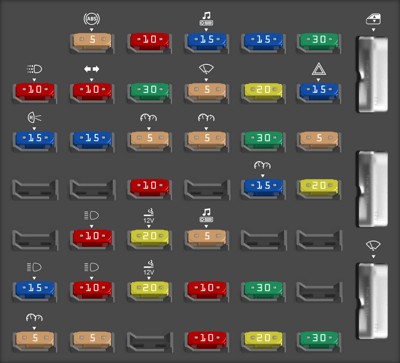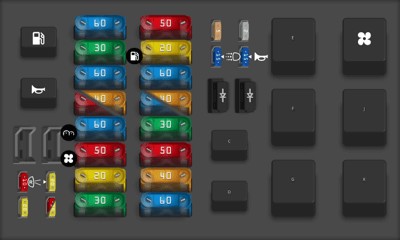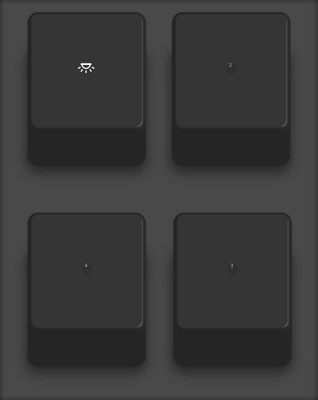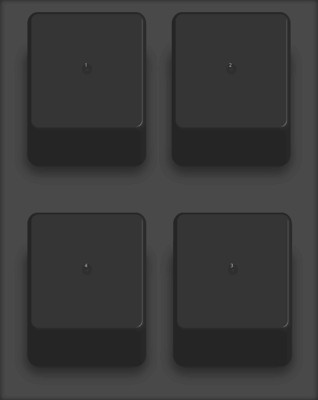Maintaining the electrical system in your 2006 Ford E-250 4.6L is crucial for its overall performance and reliability. Understanding the fuse box locations and their layouts is a fundamental skill for any owner or mechanic. Fuses protect your vehicle’s electrical circuits from overloads, preventing damage to components. When diagnosing electrical issues, checking fuses should always be one of the first steps. This guide will help you pinpoint the fuse locations in your 2006 Ford E-250, specifically focusing on aspects relevant to OBD2 diagnostics and the 4.6L engine.
Decoding the Fuse Box Locations on Your 2006 Ford E-250
Unlike some vehicles with a single fuse box, the 2006 Ford E-250 is equipped with four distinct fuse box locations. Knowing where each is situated is the first step in effectively troubleshooting electrical problems. These locations are:
- Passenger Compartment Fuse Panel: This is likely the most frequently accessed fuse box, typically located inside the vehicle.
- Power Distribution Box: Usually found in the engine compartment, this box houses high-current fuses and relays.
- Instrument Panel Relay Module: Another interior location, often behind or under the dashboard, containing relays for various systems.
- Engine Compartment Relay Module: Located in the engine bay, this module manages relays for engine and related functions.
Let’s explore each location in detail to help you navigate your 2006 Ford E-250’s electrical system.
Passenger Compartment Fuse Panel
The passenger compartment fuse panel is generally the most accessible for quick checks and fuse replacements. Its location is designed for easy access from inside the van.
 Passenger compartment fuse panel diagram for 2006 Ford E-250, interior fuse box location
Passenger compartment fuse panel diagram for 2006 Ford E-250, interior fuse box location
This fuse box controls many of the interior and convenience features of your E-250. The following table details the fuses within this panel:
| Type | No. | Description |
|---|---|---|
| Fuse MINI 5A | 1 | 4-Wheel Anti-lock Brake System (4WABS) module |
| Fuse MINI 10A | 2 | Remote Keyless Entry (RKE), O/D cancel, IVD module |
| Fuse MINI 15A | 3 | Trip computer, Radio, Overhead console |
| Fuse MINI 15A | 4 | Courtesy lamps |
| Fuse MINI 30A | 5 | Power lock switches, Power locks without RKE |
| Fuse MINI 10A | 6 | Brake-shift interlock, Daytime Running Lamps (DRL) module |
| Fuse MINI 10A | 7 | Multi-function switch, Turn signals |
| Fuse MINI 30A | 8 | Radio capacitor(s), Ignition coil, Powertrain Control Module (PCM) diode, PCM power relay |
| Fuse MINI 5A | 9 | Wiper control module |
| Fuse MINI 20A | 10 | Main light switch, Park lamps, License lamp (external lamps), Multi-function switch (flash-to-pass) |
| Fuse MINI 15A | 11 | Multi-function switch (hazards), Brake lamp switch, Brake lamps |
| Fuse MINI 15A | 12 | Back-up lamps, Auxiliary battery relay [gasoline engine only] |
| Fuse MINI 15A | 13 | Blend door actuator, Function selector switch |
| Fuse MINI 5A | 14 | Instrument cluster |
| Fuse MINI 5A | 15 | Trailer battery charge relay, Cluster |
| Fuse MINI 30A | 16 | Power seats |
| Fuse MINI 5A | 17 | Power mirrors |
| Fuse MINI 10A | 20 | Restraints |
| Fuse MINI 15A | 22 | Memory power radio, Battery saver relay, Instrument cluster, Courtesy lamp relay, Accessory delay relay |
| Fuse MINI 20A | 23 | Power locks w/RKE |
| Fuse MINI 10A | 25 | Left headlamp (low beam) |
| Fuse MINI 20A | 26 | Cigar lighter, Diagnostics |
| Fuse MINI 5A | 27 | Radio |
| Fuse MINI 15A | 30 | Headlamps (high beam indicator) |
| Fuse MINI 10A | 31 | Right headlamp (low beam) |
| Fuse MINI 20A | 32 | Power point #1 (instrument panel) |
| Fuse MINI 10A | 33 | Start relay |
| Fuse MINI 30A | 34 | IP Body builder connector #3 |
| Fuse MINI 5A | 36 | Instrument illumination |
| Fuse MINI 5A | 37 | Airbag deactivation switch |
| Fuse MINI 10A | 39 | Trailer tow electric brake, Center High-Mounted Stop Lamp (CHMSL), Brake lamps |
| Fuse MINI 20A | 40 | Power point #2 (2nd row seating position – driver side) |
| Fuse MINI 30A | 41 | Modified vehicle |
| Circuit breaker ATO | 42 | Power windows |
| Circuit breaker ATO | 44 | Wiper/washer |
Power Distribution Box
Located in the engine compartment, the power distribution box handles higher amperage circuits and is critical for engine and vehicle operation.
 Power distribution box diagram for 2006 Ford E-250, engine bay fuse location
Power distribution box diagram for 2006 Ford E-250, engine bay fuse location
This box contains fuses and relays that are vital for the 4.6L engine and other essential systems. Here’s a breakdown of its components:
| Type | No. | Description |
|---|---|---|
| Diode ATO | 1 | Powertrain Control Module (PCM) diode |
| Diode ATO | 2 | Auxiliary battery diode |
| Fuse MINI 15A | 3 | Daytime Running Lamps (DRL) module, A/C clutch |
| Fuse MINI 5A | 4 | Heated PCV [4.6L and 6.8L gasoline engines] |
| Fuse MINI 15A | 5 | Horn relay |
| Fuse MINI 2A | 6 | Brake pressure switch |
| Fuse MAXI 60A | 7 | Ignition switch, Accessory delay |
| Fuse MAXI 40A | 8 | Trailer battery charge relay |
| Fuse MAXI 50A | 9 | Modified vehicle power |
| Fuse MAXI 30A | 10 | Electric brake controller |
| Fuse MAXI 60A | 11 | [4-Wheel Anti-lock Brake System (4WABS)] |
| Fuse MAXI 40A | 11 | [AdvanceTrac with RSC] |
| Fuse MAXI 60A | 12 | I/P fuses 29, 34, 35, 40 and 41 |
| Fuse MAXI 20A | 13 | Fuel pump relay |
| Fuse MAXI 50A | 14 | Auxiliary blower relay |
| Fuse MAXI 30A | 15 | Main light switch |
| Fuse MAXI 20A | 16 | Injectors [gasoline engines] |
| Fuse MAXI 50A | 17 | Blower motor relay (blower motor) |
| Fuse MAXI 60A | 18 | Engine compartment fuses 3, 5 and 26, Instrument panel fuses 26 and 32, Start relay |
| Fuse MAXI 50A | 19 | IDM relay [diesel engine only] |
| Fuse MAXI 40A | 19 | AdvanceTrac with RSC [gasoline engines only ] |
| Fuse MAXI 60A | 20 | Auxiliary battery relay [gasoline engine only], PDB fuses 8 and 24 |
| Fuse MAXI 30A | 21 | PCM power relay, PDB fuse 27 |
| Fuse MAXI 60A | 22 | I/P fuses 4, 5, 10, 11, 16, 17, 22 and 23, Circuit breaker 44 |
| Fuse MINI 10A | 23 | Alternator field [diesel engine only] |
| Fuse MINI 20A | 23 | CMS, HEGOS, MAF, EGR, A/C clutch relay [gasoline engine only] |
| Fuse MINI 20A | 24 | Trailer tow running lamps and back-up lamp relays |
| Fuse MINI 20A | 26 | Trailer tow turn signals |
| Fuse MINI 10A | 27 | PCM |
| Relay | A | Fuel pump relay |
| Relay | B | Horn relay |
| Relay | C | Trailer back-up lamps relay |
| Relay | D | Trailer running lamps relay |
| Relay | E | Trailer battery charge relay |
| Relay | F | IDM relay [diesel only], IVD [gasoline only] |
| Relay | G | PCM relay |
| Relay | H | Blower motor relay |
| Relay | J | Accessory delay relay |
| Relay | K | Start relay |
Instrument Panel Relay Module
The instrument panel relay module, while less frequently needed for fuse checks, houses important relays for interior systems.
 Instrument panel relay module diagram for 2006 Ford E-250, interior relay location
Instrument panel relay module diagram for 2006 Ford E-250, interior relay location
Details of the relays in this module are as follows:
| Type | No. | Description |
|---|---|---|
| Relay | 1 | Interior lamps |
| Relay | 2 | Open |
| Relay | 3 | Open |
| Relay | 4 | Battery saver |
Engine Compartment Relay Module
Similar to the power distribution box, the engine compartment relay module is located in the engine bay and contains relays for engine-related functions.
 Engine compartment relay module diagram for 2006 Ford E-250, engine relay location
Engine compartment relay module diagram for 2006 Ford E-250, engine relay location
This module is crucial for systems directly related to the 4.6L engine’s operation. Here’s the relay layout:
| Type | No. | Description |
|---|---|---|
| Relay | 1 | PCM back-up lamp |
| Relay | 2 | A/C control |
| Relay | 3 | Trailer tow right turn |
| Relay | 4 | Trailer tow left turn |
OBD2 Port Location and Fuses
While this article focuses on fuse box locations, it’s important to briefly mention the OBD2 port as it’s integral to vehicle diagnostics. The OBD2 port in a 2006 Ford E-250 is typically located under the dashboard on the driver’s side. It’s used to connect diagnostic scanners to read vehicle data and trouble codes.
Although there isn’t a specific “OBD2 fuse,” the diagnostic port’s power supply is often linked to fuses in the passenger compartment fuse panel or the power distribution box. If you’re experiencing issues with your OBD2 scanner not powering up, checking the “Diagnostics” fuse (Fuse #26 in the passenger compartment fuse panel) is a good starting point.
Conclusion
Understanding the fuse box locations and layouts in your 2006 Ford E-250 4.6L is essential for effective vehicle maintenance and troubleshooting. By using this guide, you can quickly locate the relevant fuse box and identify the specific fuse or relay related to your electrical issue. Always refer to your vehicle’s owner’s manual for the most accurate and up-to-date information and consult a qualified mechanic for complex electrical repairs.